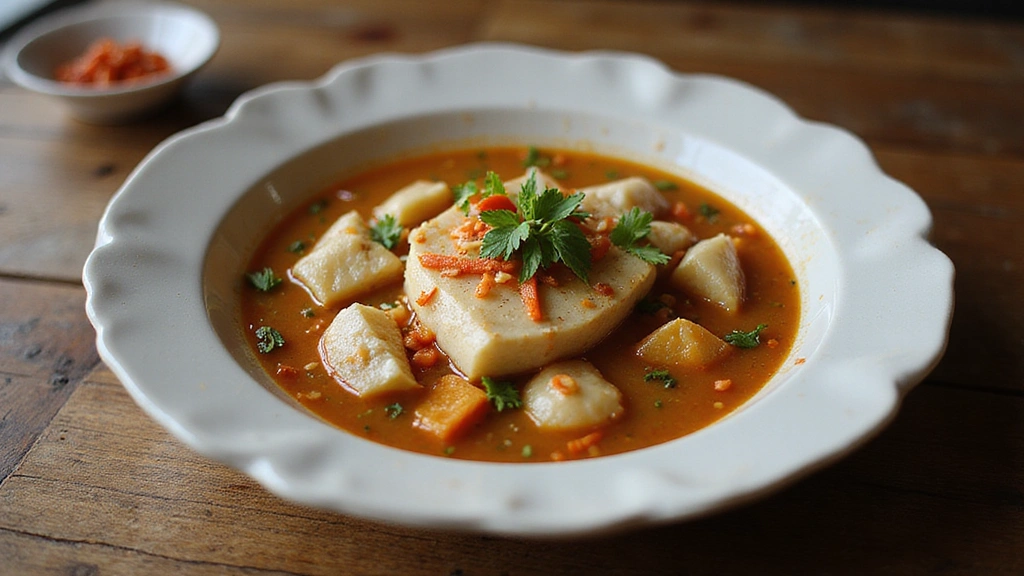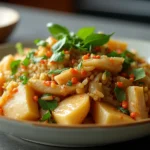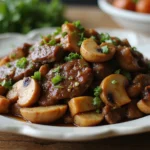Traditional Hong Kong Chinese soups are a warm embrace in a bowl, perfect for soothing the soul and nourishing the body.
Rich in flavors and textures, these soups often blend aromatic herbs, tender meats, and fresh vegetables, creating a delightful symphony for the palate.
I first experienced the heartwarming comfort of these soups during a chilly evening in Hong Kong, where families gather to share meals and stories.
Whether enjoyed on a rainy day or as a centerpiece for festive gatherings, these recipes are sure to bring comfort and joy to your dining table.
The History and Cultural Significance
• Traditional Hong Kong Chinese soups trace their origins to ancient Chinese medicinal practices, where the art of soup-making was believed to promote health and vitality.
• Over the years, these soups evolved, incorporating local ingredients and flavors that reflect Hong Kong’s vibrant culinary landscape, melding Cantonese and Western influences.
• In Chinese culture, these soups traditionally appear at family gatherings, festivals, and celebrations, symbolizing unity, warmth, and the importance of nourishment.
• While many variations exist across different regions of China, the authentic Hong Kong version maintains a delicate balance of flavors and a focus on fresh, high-quality ingredients.
Recipe Overview
Nutritional Information (per serving)
Ingredients
Essential Equipment Guide
Stockpot: A sturdy stockpot is essential for simmering the soup, allowing for even heat distribution and ample space for ingredients. Look for a heavy-bottomed pot to prevent scorching, and consider one with a lid to trap steam and flavors.
Fine Mesh Strainer: This tool is crucial for achieving a clear broth by filtering out impurities and solid ingredients. A good strainer should fit comfortably over your stockpot for easy pouring and should be durable enough to withstand regular use.
Soup Ladle: A ladle is important for serving the soup gracefully. Choose one with a deep bowl to ensure easy serving of both broth and solids, and consider a heat-resistant material to prevent melting.
Preparation Methods
Blanching: This technique involves briefly boiling the meat before adding it to the soup to remove impurities and excess fat. Blanching helps create a clearer broth and enhances the overall flavor of the soup. To master this, ensure that your water is at a rolling boil before adding the meat and then drain and rinse under cold water.
Simmering: Simmering is essential for developing flavors in the broth without boiling it vigorously. It allows the ingredients to meld together while keeping the texture tender. Keep an eye on the heat; a gentle simmer should produce small bubbles rising to the surface rather than a rolling boil.
Straining: This step is crucial for achieving a clear and smooth soup. After cooking, use a fine mesh strainer to remove solid bits from the broth. Pour slowly and gently press the solids to extract as much flavor as possible.
Step 1: Prepare Ingredients

Gather all your ingredients before starting the cooking process.
Wash and chop the vegetables as indicated in the ingredient list.
Make sure to slice the ginger and quarter the onion properly for even cooking.
This preparation will streamline your cooking process and ensure everything is ready to go.
Step 2: Blanch the Meats
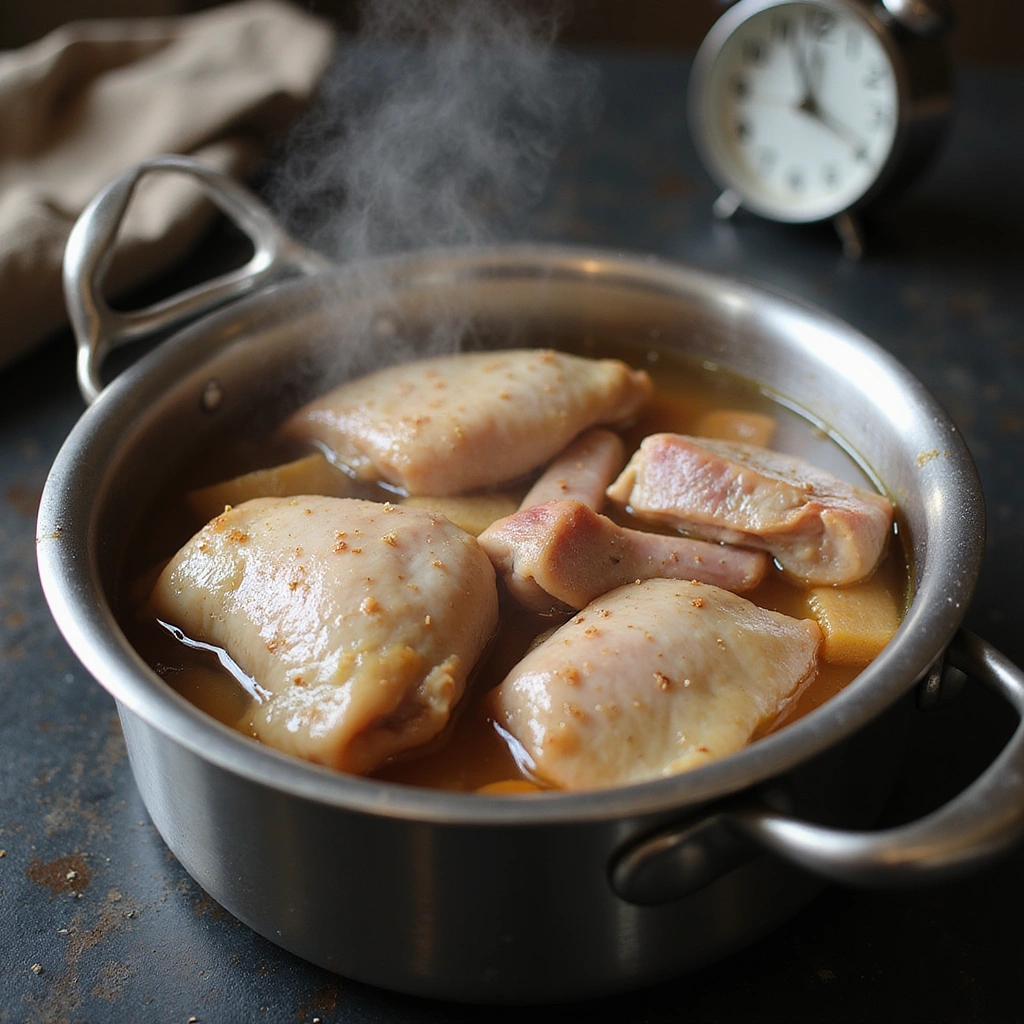
Fill a large pot with water and bring it to a rolling boil.
Add the chicken thighs and pork ribs to the boiling water and let them cook for about 5 minutes.
Once done, drain the meat and rinse it under cold water to stop the cooking process.
This step removes impurities and excess fat, resulting in a cleaner broth.
Step 3: Start the Broth
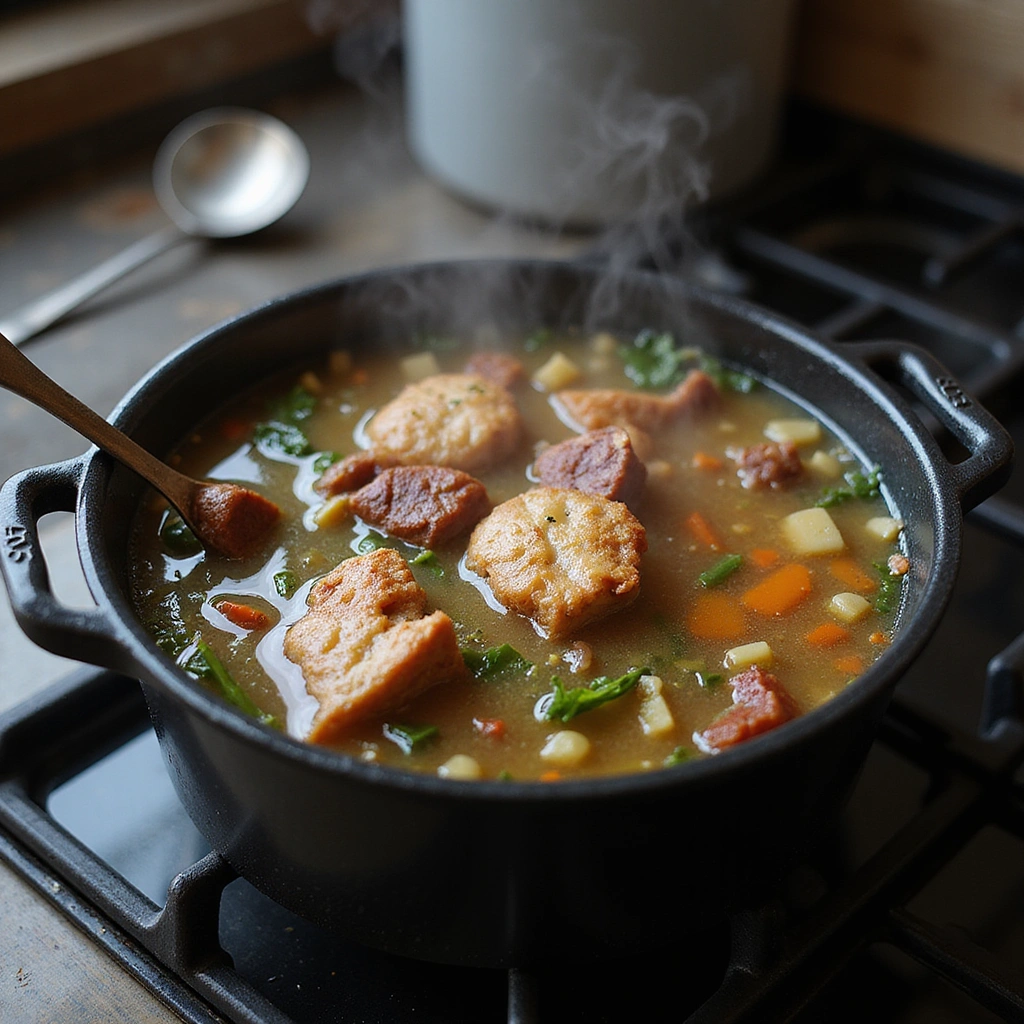
In a clean stockpot, add 8 cups of fresh water and the blanched meats.
Bring the water to a boil over high heat, then reduce it to a gentle simmer.
Add the quartered onion and sliced ginger to the pot to infuse flavor.
Allow the broth to simmer for 1.5 to 2 hours, skimming off any foam that appears on the surface.
Step 4: Add Vegetables

Once the broth has simmered for an hour, add the sliced carrots and goji berries.
These ingredients will add sweetness and color to the soup.
Continue to simmer for an additional 30 minutes until the vegetables are tender.
Stir occasionally to ensure even cooking.
Step 5: Season the Broth

After the vegetables are tender, taste the broth to check for seasoning.
Add salt and white pepper gradually, stirring and tasting until the desired flavor is reached.
This step is crucial for balancing the flavors in the soup.
Remember, the broth should be savory but not overly salty.
Step 6: Strain the Broth

Once seasoned, carefully strain the soup through a fine mesh strainer into another pot.
This will separate the liquid from the solids, resulting in a clear broth.
Press down gently on the solids to extract any remaining flavor.
Discard the solids and return the clear broth to the pot.
Step 7: Serve the Soup

Ladle the hot broth into bowls, ensuring each serving has a piece of meat and some vegetables.
Garnish with fresh herbs like cilantro or green onions for added flavor and presentation.
Serve immediately while the soup is hot and fragrant.
Encourage guests to enjoy it with steamed rice or noodles for a complete meal.
Step 8: Enjoy Your Creation
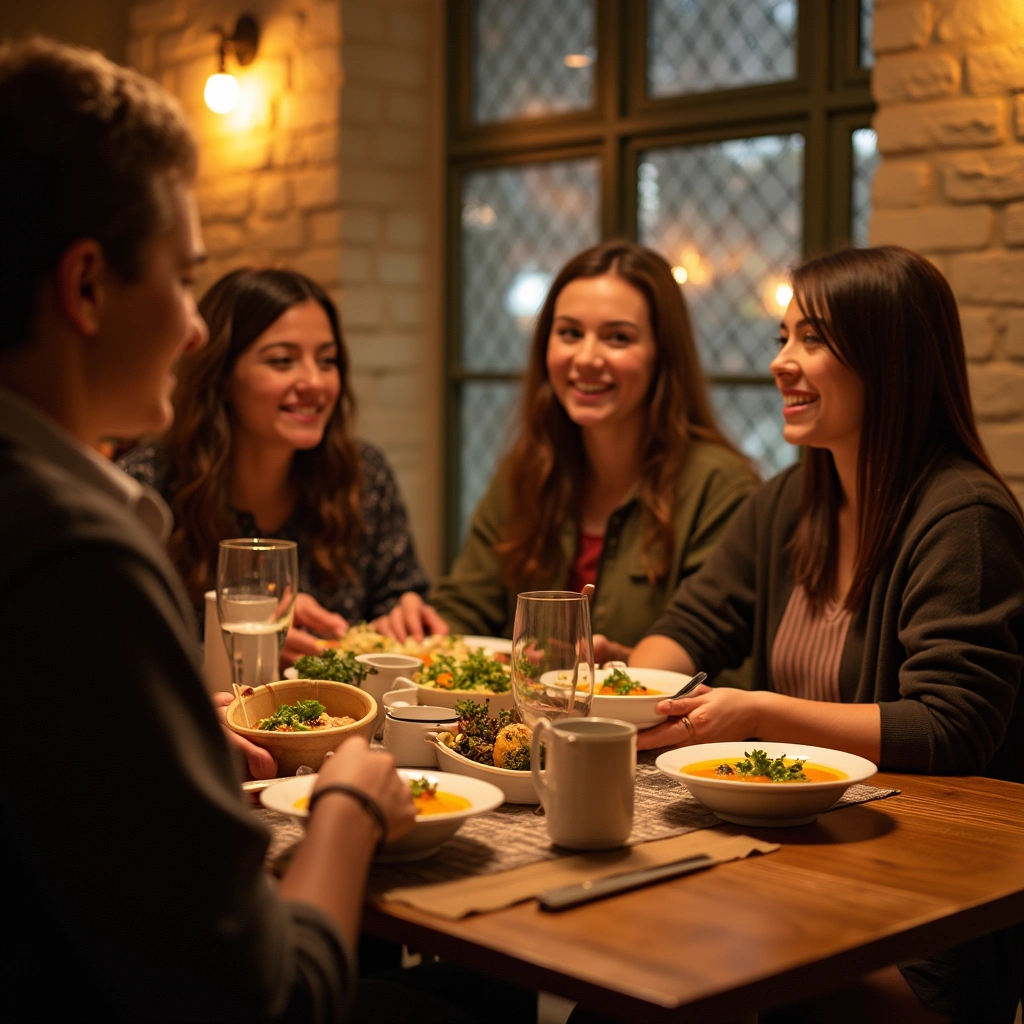
Gather your family or friends around the table to enjoy your homemade soup.
Take a moment to appreciate the aromas and flavors you have created.
Share stories and laughter while savoring each warm, comforting bowl.
This soup is not just a meal; it’s a moment of connection.
Critical Timing and Temperature Guide
Simmering the Broth: Maintain a gentle simmer for 1.5 to 2 hours. Look for small bubbles rising to the surface, indicating proper temperature. Avoid boiling, as this can lead to a cloudy broth.
Cooking Vegetables: Add vegetables after the initial simmering of the broth. Cook for about 30 minutes until tender but not mushy. Overcooked vegetables lose their texture and freshness.
Seasoning: Taste and adjust seasoning towards the end of cooking. Adding salt too early can result in a too-salty broth as it reduces. Gradually add seasonings to achieve the desired flavor balance.
Pro Tips for Hong Kong Chinese Soup Recipes Warm And Comforting
• Ingredient Selection: Opt for high-quality meats and fresh vegetables to enhance the soup’s flavor. The chicken thighs should be plump and firm, while vegetables should be vibrant and crisp.
• Preparation Secret: Rinsing the blanched meats under cold water removes impurities and results in a clearer broth.
• Temperature Management: Ensure your water is at a rolling boil before adding the meats. This helps in effective blanching and flavor extraction.
• Texture Enhancement: Avoid overcooking the vegetables; they should be cooked just until tender to maintain a pleasant bite.
• Flavor Layering: Introduce ingredients gradually; the goji berries should be added later to preserve their texture and sweetness.
• Make-Ahead Strategies: Prepare the broth in advance and store it in the refrigerator for up to three days or freeze for longer storage. Reheat gently to preserve flavor.
• Restaurant-Quality Finishing Touches: Garnish with fresh herbs just before serving to elevate both the flavor and presentation of the soup.
• Equipment Optimization: Use a heavy-bottomed pot to prevent scorching and ensure even cooking throughout.
Troubleshooting Common Issues
• Broth Too Oily: If the broth is greasy, it may be due to excess fat from the meats. Skim off the surface oil once the soup has cooled slightly, or use a fat separator for better results.
• Flavor Too Mild: This can occur if seasonings were added too late. Always taste and adjust seasoning gradually throughout cooking to build flavor.
• Vegetables Mushy: Overcooked vegetables can spoil the texture. Add them later in the cooking process to ensure they remain crisp.
• Broth Cloudy: If the broth is cloudy, it may be due to boiling instead of simmering. Always keep the heat low to achieve a clear broth.
• Insufficient Flavor: If the soup lacks depth, consider adding more ginger or soy sauce gradually until you reach the desired flavor profile.
• Overly Salty Broth: If too salty, dilute with additional water and adjust seasoning with other flavors like vinegar or lime juice to balance.
Variations and Regional Differences
• Cantonese Herbal Soup: This variation often includes traditional Chinese herbs like angelica root and licorice for added health benefits, emphasizing medicinal qualities.
• Spicy Sichuan Soup: Incorporating Sichuan peppercorns and chili oil transforms the soup into a spicy version, showcasing the regional heat preferences.
• Vegetarian Version: Replace meat with mushrooms and tofu, using vegetable broth as a base to create a plant-based alternative that retains the comforting essence.
• Modern Interpretations: Contemporary adaptations might include quinoa or barley as a nutritious addition, catering to current health trends while respecting traditional flavors.
Food Science Behind the Recipe
• Gelatinization: The slow simmering process allows collagen from the meats to break down into gelatin, which gives the broth its rich texture and mouthfeel.
• Maillard Reaction: The browning of meats during the initial cooking stages enhances the flavor profile through complex chemical reactions that develop savory notes.
• Emulsification: Proper seasoning at the right moments helps to create a balanced flavor that feels cohesive on the palate, ensuring no one ingredient overpowers the others.
Frequently Asked Questions
What’s the most common mistake people make when preparing Traditional Hong Kong Chinese Soup? Many overlook the importance of proper seasoning throughout the cooking process, leading to an unbalanced flavor. Adjust gradually and continuously taste.
Can I prepare components of this dish in advance? Yes, the broth can be made up to three days in advance and stored in the refrigerator. Reheat gently before serving.
How do I adapt this recipe for dietary restrictions? For gluten-free options, use tamari instead of soy sauce and ensure all other ingredients are gluten-free.
What’s the best way to store and reheat leftovers? Store in an airtight container in the fridge for up to three days. Reheat on the stove over low heat, stirring occasionally.
Can I freeze this dish? Yes, the soup freezes well. Allow it to cool completely before transferring to freezer-safe containers. Thaw in the refrigerator overnight before reheating.
What wine or beverages pair best with this dish? Light, crisp white wines like Sauvignon Blanc or a refreshing jasmine tea complement the soup’s flavors beautifully.
How can I scale this recipe up for a crowd? Simply multiply the ingredient amounts while ensuring your pot is large enough to accommodate the increased volume.
What side dishes complement this recipe best? Steamed rice or simple stir-fried greens pair perfectly, balancing the soup’s richness with additional textures.
How do professional chefs elevate this dish for restaurant service? Chefs often add finishing oils or freshly chopped herbs right before serving, enhancing both the aroma and presentation.
Serving and Presentation Guide
• Traditional Presentation: Serve in deep bowls to showcase the soup’s richness, garnished with freshly chopped cilantro and a sprinkle of white pepper. Use a wooden spoon for an authentic touch.
• Modern Plating Ideas: Use clear glass bowls to emphasize the colors of the ingredients, layering meats and vegetables attractively for visual appeal.
• Accompaniment Suggestions: Serve with a side of steamed jasmine rice or crispy spring rolls to enhance the meal experience.
• Special Occasion Presentation: For festive occasions, consider serving the soup in large communal bowls with individual garnishing options, encouraging guests to personalize their servings.
Conclusion
I hope you take the time to try making this Traditional Hong Kong Chinese Soup at home.
Each bowl is a journey through culture and comfort, bringing warmth to any meal.
May it bring joy to your table and create lasting memories with those you cherish.

